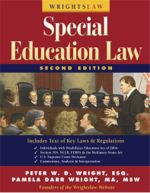IDEA 2004:
Commentary
Law & Regs l Commentary l Guidance l Articles l News
Publications l Wrightslaw: Special Education Law, 2nd Edition
Print
this page
The reauthorization of any law brings differing interpretations and questions. The information in IDEA 2004 at Wrightslaw will help you find answers to your questions. How IDEA 2004 at Wrightslaw is organized:
Get Answers to Questions in the Commentary
When the Education Department published the federal special
education regulations in August 2006, they also published the Analysis
of Comments and Changes ("Commentary") and Model
Forms.
In the Commentary, the Department explains why a regulation
was changed, not changed, and often clarifies the "plain meaning" of a term. (Federal Register, Volume 71, pages 46540-46845,
published on August 14, 2006).
This Analysis of Comments and Changes or Commentary
provides definitions and discussions of legal terms in IDEA 2004 and
the special education
regulations. The document includes a Summary
of the Major Changes in the Regulations." (pages 46540-46547)
A very helpful Index
begins on page 46817 and ends on page 46845.
The IDEA
2004 regulations (34 CFR Part 300) were published in the Federal
Register (pages 46755 to 46817). (Click
here to download the IDEA
2004 regulations that were reformatted into several easy-to-read
files.)
The
entire
307 page document is available as one very large
pdf file.
Tip: If you want to download
this document, right click the file, and save it to disk. Once you
have saved the document on your computer, you can open it and print
it.
Topics in Commentary
To make this information more accessible, we divided the large document
into 15 files on different topics (i.e., evaluations, IEPs,
ESY, etc). We recommend that you download these files on your computer,
especially the Cover Page, Table of Contents, and Index.
Tip: You might want to download
and print the Cover Page first. It makes a great bookmark in your
brand new law book and will quickly become a "conversation piece" when you attend special education meetings. It looks very official,
because it is!
Cover
Page
Analysis and Commentary by topic
Definitions / Regs 1-100 (pages
46547 through 46579)
ESY,
LRE, etc / Regs 101-230 (pages 46579 through 46629)
Evaluations
/ Regs 300-311 (pages 46629 through 46661)
IEPs / Regs 320-328 (pages 46661 through 46688)
Procedures / Regs 501-520 (pages 46688 through 46713)
Discipline
/ Regs 530-537 (pages
46713 through 46730)
Monitoring
/ Regs 600-815 (pages 46730 through 46743)
Additional information from the U.S. Department
of Education
Summary
of Changes (pages 46540 through 46547)
Discussion
/ Costs / Paperwork (pages 46743 through 46751)
Table
of Contents (pages 46753 through 46755)
IDEA
2004 Regulations (pages 46755 through 46817)
Index
of Regulations
(pages
46817 through 46845)
Complete 307 page document
IDEA 2004 Regulations
Click here to download the federal special education regulations reformatted into several easy to read files.
Wrightslaw: Special Education Law, 2nd Edition
 Wrightslaw: Special Education Law, 2nd Edition (ISBN: 978-1-892320-16-2) by Peter Wright and Pamela Wright is available in two formats. The book includes:
Wrightslaw: Special Education Law, 2nd Edition (ISBN: 978-1-892320-16-2) by Peter Wright and Pamela Wright is available in two formats. The book includes:
* Full text of the Individuals with Disabilities Education Act of 2004 and IDEA 2004 regulations with analysis and commentary
* Section 504 of the Rehabilitation Act
* No Child Left Behind Act
* Family Education Rights and Privacy Act (FERPA)
* McKinney-Vento Homeless Act
* Decisions from the U. S. Supreme Court
* References and resources
Formats How to Order Discounts The E-book
Synopsis Table of Contents About the Authors Early Reviews
Wrightslaw: Special Education Law, 2nd Edition is designed to meet the needs of parents, teachers, advocates, attorneys, related services providers, school psychologists, administrators, college professors, hearing officers, and employees of district and state departments of education.
Use of Commentary in Wrightslaw: Special Education Law, 2nd Edition
In Wrightslaw: Special Education Law, 2nd Edition, we often refer to the Commentary as a guide to interpretations from the U.S. Department of Education. For example, if a child with an IEP moves from one jurisdiction to another, the child is entitled to "services comparable to those in the child's IEP from the previous public agency." (see Regulation 34 CFR 300.323, subsections (e) and (f)) The term "comparable" is not defined in the IDEA 2004 statute or in the special education regulations.
However, the Commentary includes a discussion about the word "comparable" (Federal Register, page 46681). The Department of Education explains, "we do not believe it is necessary to define ‘‘comparable services’’ in these regulations because the Department interprets ‘‘comparable’’ to have the plain meaning of the word, which is ‘‘similar’’ or ‘‘equivalent.’’
Tip: At a minimum, we recommend that you print 3 key files and keep them in your copy of Wrightslaw: Special Education Law, 2nd Edition - the Cover Page, Table of Contents, and Index.
If you use the Cover Page as a bookmark in your special ed law book, it will quickly become a "conversation
piece" when you attend special education meetings.
To Top

